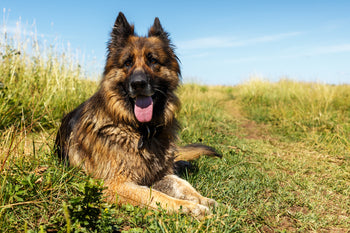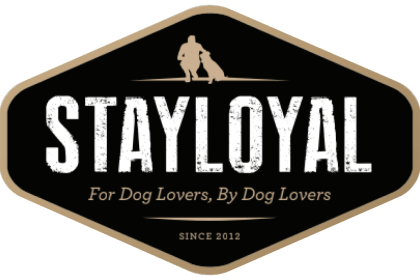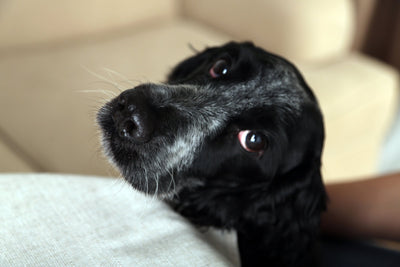Caring for and Preventing Elbow Calluses in Dogs!
|

As a dedicated dog owner, you want the best for your four-legged friend, from their health to their comfort. One common issue that can arise, especially in larger breeds, is the development of elbow calluses. These rough patches of thickened skin can be uncomfortable for your furry companion. In this article, we'll delve into what elbow calluses are, why they form, and most importantly, how you can care for and prevent them to ensure your dog's well-being.
Understanding Elbow Calluses:
Elbow calluses, also known as pressure sores or hygromas, are areas of thickened and sometimes hairless skin that typically develop over bony prominences, such as the elbows, hocks, and hips of dogs. These calluses form as a result of repeated pressure and friction between the dog's body and the hard surfaces they lie on.
Causes of Elbow Calluses:
Several factors contribute to the formation of elbow calluses in dogs:
1. Weight and Size: Larger and heavier breeds are more prone to developing calluses due to the increased pressure exerted on their joints and bony areas.
2. Lying on Hard Surfaces: Dogs that frequently lie down on hard surfaces, such as tile or hardwood floors, are more likely to develop calluses.
3. Age and Activity Level: Older dogs with reduced muscle mass and less subcutaneous fat are more susceptible. Additionally, dogs that spend extended periods lying down due to age or mobility issues are at greater risk.
4. Improper Bedding: Beds that don't provide sufficient cushioning can exacerbate callus formation.
Caring for Elbow Calluses:
If your dog already has elbow calluses, there are steps you can take to provide comfort and promote healing:
1. Keep the Area Clean: Regularly clean the callused area with a mild, dog-friendly cleanser to prevent infection.
2. Apply Moisturising Creams: Use veterinary-recommended moisturising creams to keep the skin hydrated and prevent further cracking.
3. Protect the Area: If the callus is open or prone to cracking, consider protecting it with a padded cover or a soft bandage.
4. Provide Adequate Bedding: Invest in a high-quality, supportive dog bed with memory foam or other cushioning material to alleviate pressure on the elbows.
Preventing Elbow Calluses:
Prevention is key to keeping your dog's elbows comfortable and healthy:
1. Choose the Right Bedding: Provide your dog with a well-padded bed that offers support and cushioning. Orthopedic beds are particularly effective in preventing calluses.
2. Use Rugs or Mats: Place rugs or mats in areas where your dog frequently lies down to create a softer surface.
3. Encourage Movement: Encourage your dog to change positions and move around regularly, especially if they tend to lie in the same spot for extended periods. If they are laying around more than usual, consider the possibility of your dog having other health issues like sore joints.
4. Weight Management: Maintain a healthy weight for your dog through proper diet, correct portions, and regular exercise. This helps reduce pressure on their joints and bony areas.
5. Exercise Routine: Incorporate regular, moderate exercise into your dog's routine to promote muscle tone and blood circulation.
When to Consult Your Veterinarian:
While many cases of elbow calluses can be managed at home, there are situations where veterinary attention could be needed:
- Infection: If the callus becomes red, swollen, or oozes, it could be infected and requires treatment.
- Pain or Discomfort: If your dog shows signs of pain or discomfort, consult your veterinarian for appropriate pain management.
- Persistent Open Sores: If the callus consistently cracks open or does not heal despite proper care, professional intervention may be needed.
Caring for your dog's comfort and well-being includes preventing and managing issues like elbow calluses. By understanding the causes, taking preventive measures, and providing proper care, you can ensure your furry companion's joints and skin remain healthy and comfortable. With the right approach, your dog can enjoy a comfortable, happy, and active life without the discomfort of elbow calluses. Always remember, your veterinarian is there to provide guidance and support for your dog's health, so don't hesitate to reach out if you have concerns or questions.
Understanding Elbow Calluses:
Elbow calluses, also known as pressure sores or hygromas, are areas of thickened and sometimes hairless skin that typically develop over bony prominences, such as the elbows, hocks, and hips of dogs. These calluses form as a result of repeated pressure and friction between the dog's body and the hard surfaces they lie on.
Causes of Elbow Calluses:
Several factors contribute to the formation of elbow calluses in dogs:
1. Weight and Size: Larger and heavier breeds are more prone to developing calluses due to the increased pressure exerted on their joints and bony areas.
2. Lying on Hard Surfaces: Dogs that frequently lie down on hard surfaces, such as tile or hardwood floors, are more likely to develop calluses.
3. Age and Activity Level: Older dogs with reduced muscle mass and less subcutaneous fat are more susceptible. Additionally, dogs that spend extended periods lying down due to age or mobility issues are at greater risk.
4. Improper Bedding: Beds that don't provide sufficient cushioning can exacerbate callus formation.
Caring for Elbow Calluses:
If your dog already has elbow calluses, there are steps you can take to provide comfort and promote healing:
1. Keep the Area Clean: Regularly clean the callused area with a mild, dog-friendly cleanser to prevent infection.
2. Apply Moisturising Creams: Use veterinary-recommended moisturising creams to keep the skin hydrated and prevent further cracking.
3. Protect the Area: If the callus is open or prone to cracking, consider protecting it with a padded cover or a soft bandage.
4. Provide Adequate Bedding: Invest in a high-quality, supportive dog bed with memory foam or other cushioning material to alleviate pressure on the elbows.
Preventing Elbow Calluses:
Prevention is key to keeping your dog's elbows comfortable and healthy:
1. Choose the Right Bedding: Provide your dog with a well-padded bed that offers support and cushioning. Orthopedic beds are particularly effective in preventing calluses.
2. Use Rugs or Mats: Place rugs or mats in areas where your dog frequently lies down to create a softer surface.
3. Encourage Movement: Encourage your dog to change positions and move around regularly, especially if they tend to lie in the same spot for extended periods. If they are laying around more than usual, consider the possibility of your dog having other health issues like sore joints.
4. Weight Management: Maintain a healthy weight for your dog through proper diet, correct portions, and regular exercise. This helps reduce pressure on their joints and bony areas.
5. Exercise Routine: Incorporate regular, moderate exercise into your dog's routine to promote muscle tone and blood circulation.
When to Consult Your Veterinarian:
While many cases of elbow calluses can be managed at home, there are situations where veterinary attention could be needed:
- Infection: If the callus becomes red, swollen, or oozes, it could be infected and requires treatment.
- Pain or Discomfort: If your dog shows signs of pain or discomfort, consult your veterinarian for appropriate pain management.
- Persistent Open Sores: If the callus consistently cracks open or does not heal despite proper care, professional intervention may be needed.
Caring for your dog's comfort and well-being includes preventing and managing issues like elbow calluses. By understanding the causes, taking preventive measures, and providing proper care, you can ensure your furry companion's joints and skin remain healthy and comfortable. With the right approach, your dog can enjoy a comfortable, happy, and active life without the discomfort of elbow calluses. Always remember, your veterinarian is there to provide guidance and support for your dog's health, so don't hesitate to reach out if you have concerns or questions.








